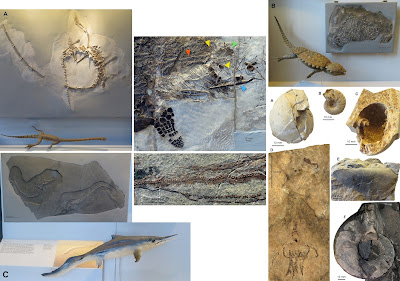 |
| The marine conservation deposits of Monte San Giorgio (Switzerland, Italy): the prototype of Triassic black shale Lagerstätten. in Klug, Spiekman, Bastiaans, Scheffold et Scheyer, 2024. |
Abstract
Marine conservation deposits (‘Konservat-Lagerstätten’) are characterized by their mode of fossil preservation, faunal composition and sedimentary facies. Here, we review these characteristics with respect to the famous conservation deposit of the Besano Formation (formerly Grenzbitumenzone; including the Anisian–Ladinian boundary), and the successively younger fossil-bearing units Cava inferiore, Cava superiore, Cassina beds and the Kalkschieferzone of Monte San Giorgio (Switzerland and Italy). We compare these units to a selection of important black shale-type Lagerstätten of the global Phanerozoic plus the Ediacaran in order to detect commonalities in their facies, genesis, and fossil content using principal component and hierarchical cluster analyses. Further, we put the Monte San Giorgio type Fossillagerstätten into the context of other comparable Triassic deposits worldwide based on their fossil content. The results of the principal component and cluster analyses allow a subdivision of the 45 analysed Lagerstätten into four groups, for which we suggest the use of the corresponding pioneering localities: Burgess type for the early Palaeozoic black shales, Monte San Giorgio type for the Triassic black shales, Holzmaden type for the pyrite-rich black shales and Solnhofen type for platy limestones.
Keywords: Konservat-Lagerstätten, Taphonomy, Marine reptiles, Exceptional preservation
Conclusions:
The conservation deposits of Anisian and Ladinian age of Monte San Giorgio, comprising the Besano Formation, Cava inferiore, Cava superiore, Cassina Beds, and the Kalkschieferzone, represent some of the first black shale conservation deposits of Triassic age that were thoroughly studied. Now, after a century of excavations and more than a century of research, these deposits begin to enjoy global scientific recognition (e.g., Etter, 2002a; Rieppel, 2019), and continue to produce valuable new information about the palaeobiology and evolution of Triassic vertebrates today.
With this paper, we want to highlight the key role of the conservation deposits of Monte San Giorgio: comparable to the pioneer role of the Burgess Shale for the Cambrian Lagerstätten or Solnhofen for the Mesozoic platy limestones, we highlight the pioneer role of the Besano Formation in particular as the prototype for Triassic Lagerstätten. Our simple comparison of 45 Fossillagerstätten worldwide employing principal component and hierarchical cluster analyses of 32 traits based on the ...
Christian Klug, Stephan N. F. Spiekman, Dylan Bastiaans, Beat Scheffold and Torsten M. Scheyer. 2024. The Marine Conservation Deposits of Monte San Giorgio (Switzerland, Italy): the Prototype of Triassic Black Shale Lagerstätten. Swiss Journal of Palaeontology. 143, 11. DOI: doi.org/10.1186/s13358-024-00308-7


